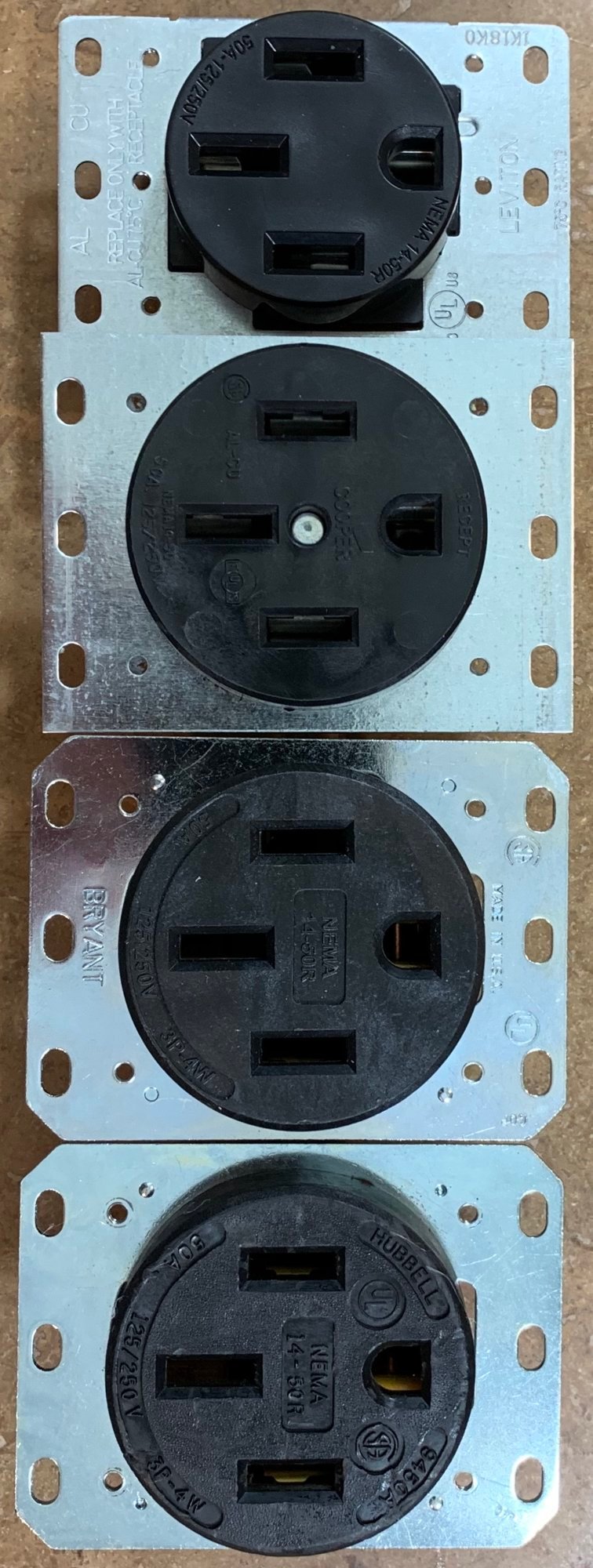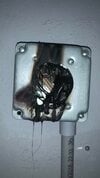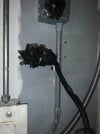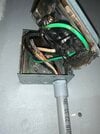Charging was interrupted in the middle of the night. Found the garage fuse was tripped and the UMC in this condition. It looks to me like the Nema 14-50 box melted down—do you folks think it was the fault of the nema plug or the UMC? It was professionally installed and has been working for 3 years without problems.
Welcome to Tesla Motors Club
Discuss Tesla's Model S, Model 3, Model X, Model Y, Cybertruck, Roadster and More.
Register
Install the app
How to install the app on iOS
You can install our site as a web app on your iOS device by utilizing the Add to Home Screen feature in Safari. Please see this thread for more details on this.
Note: This feature may not be available in some browsers.
-
Want to remove ads? Register an account and login to see fewer ads, and become a Supporting Member to remove almost all ads.
You are using an out of date browser. It may not display this or other websites correctly.
You should upgrade or use an alternative browser.
You should upgrade or use an alternative browser.
Almost burned the house down
- Thread starter gaspi101
- Start date
It’s a 100 amp box with two circuit breakers connecting this UMC and a Wallcharger—two Teslas were charging simultaneously, each on their own breaker at 32amps, the Wallcharger’s fuse did not trip and charging finished just fine. The Nema, however, looks like it didn’t make it more than an hour from the moment it started charging.That's scary. Out of curiosity, what was the amperage of the circuit that fed that outlet, and how many amps did you charge at?
RedTesY
Member
The problem would be where the heat was. Looks like most of the heat was in the UMC plug. Have your installer come and open up the receptacle and inspect/check the receptacle connections. If it all looks good behind the cover plate, time to talk with Tesla!
The receptacle is melted down completely…. As is the UMC plug…looks like the red live wire is peeled off and severed…I bet it was over tightened, came off a little, touched something and bam.The problem would be where the heat was. Looks like most of the heat was in the UMC plug. Have your installer come and open up the receptacle and inspect/check the receptacle connections. If it all looks good behind the cover plate, time to talk with Tesla!
Attachments
Tam
Well-Known Member
It's called "mobile" for a reason....melted down...
That's one of the risks of a removable plug so a hardwired High Power Wall Connector is preferable.
First-generation plugs didn't have a heat sensor so it was recalled with replacements.
Gen2 plugs are better but the risk of being overheated is still there.
It would be interesting to know who made the outlet, in other words what brand is it ?
Some of the outlets sold in the big box stores are not so good for heavy usage like charging a car for hours on end.

 teslamotorsclub.com
teslamotorsclub.com
Some of the outlets sold in the big box stores are not so good for heavy usage like charging a car for hours on end.
Master Thread: Definitive 14-50 NEMA Outlet Guide
Comparing the 2 outlets recommended by Tesla with the sub $10 big box model as well as the one I think you should buy 1. Hubbell 9450a 2. Bryant 9450fr 3. Cooper 5754n 4. Leviton 279-S00 The Hubbell and Bryant are far and away the superior product here and since Hubbell owns Bryant and these...
brucet999
Active Member
"Came off, touched something and bam" does not melt down the outlet case and plug. Shorting to the case would have cause a huge spark, local melting and tripped the breaker instantly. The photo shows no melting of the copper strands, which would certainly have happened in the event of the wire coming in contact with the opposite terminal or with ground.The receptacle is melted down completely…. As is the UMC plug…looks like the red live wire is peeled off and severed…I bet it was over tightened, came off a little, touched something and bam.
A loose connection, however, could have been arcing for some time and heating up the whole assembly to the melting point of plastic parts.
Also, "Almost burned the house down" title is hugely hyperbolic. No sign even of scorching drywall, much less evidence of nearly catching the house on fire.
Thanks for the info, it perhaps looks worse than it is to my untrained eye. So you think it was just a loose connection in the box?"Came off, touched something and bam" does not melt down the outlet case and plug. Shorting to the case would have cause a huge spark, local melting and tripped the breaker instantly. The photo shows no melting of the copper strands, which would certainly have happened in the event of the wire coming in contact with the opposite terminal or with ground.
A loose connection, however, could have been arcing for some time and heating up the whole assembly to the melting point of plastic parts.
Also, "Almost burned the house down" title is hugely hyperbolic. No sign even of scorching drywall, much less evidence of nearly catching the house on fire.
I’m glad you’re okay. Large electrical shorts like this can be scary.
Is this a Leviton brand receptacle? If so, this exact issue has been discussed in several threads over the years. This is why many people on TMC recommend installing a Hubbell, Bryant or Cooper brand NEMA 14-50 receptacle ($50-100) instead of Leviton ($10) or some other cheap brand. The difference in build quality is immediately apparent when comparing them side by side.
Even better than that is a hard-wired Wall Connector as it has fewer possible points of failure.

 teslamotorsclub.com
teslamotorsclub.com
Everyone using a NEMA 14-50 outlet for home charging should check the brand of outlet and take corrective action if necessary.
Is this a Leviton brand receptacle? If so, this exact issue has been discussed in several threads over the years. This is why many people on TMC recommend installing a Hubbell, Bryant or Cooper brand NEMA 14-50 receptacle ($50-100) instead of Leviton ($10) or some other cheap brand. The difference in build quality is immediately apparent when comparing them side by side.
Even better than that is a hard-wired Wall Connector as it has fewer possible points of failure.
Master Thread: Definitive 14-50 NEMA Outlet Guide
Comparing the 2 outlets recommended by Tesla with the sub $10 big box model as well as the one I think you should buy 1. Hubbell 9450a 2. Bryant 9450fr 3. Cooper 5754n 4. Leviton 279-S00 The Hubbell and Bryant are far and away the superior product here and since Hubbell owns Bryant and these...
Everyone using a NEMA 14-50 outlet for home charging should check the brand of outlet and take corrective action if necessary.
Johnny Vector
Member
This is almost certainly a Leviton receptacle. You can tell by the Phillips/flatblade screw head in the photo. Hubbell/Bryant receptacles have hex socket head (Allen key) clamp screws.
This, in my mind, is the biggest problem with Leviton's 14-50s. Getting the correct torque for #6 or #8 wire with a Phillips screwdriver is very difficult. Doing it with an Allen key is easy. If the wire is not clamped sufficiently, it can work for years, all the while slowly moving toward failure. Without sufficient preload on a clamp screw, any motion can make it back out. Motion, for instance, caused by thermal changes. In my business the thermal changes we have to watch out for are caused by going in and out of direct sunlight once every 97 minutes; for a charging outlet the thermal changes are caused by charging cycles. Regardless of how tight the joint is, it will heat up enough to make the parts expand when current is flowing. Without the required preload on the screw, that expansion and contraction can cause it to slowly back out. Which reduces the preload further, until finally it's no longer making a good electrical connection. Then you get resistive heat or arcing, either of which can ruin your day.
This is why the manufacturer provides a torque spec for tightening the clamp screw. For a 14-50, it's a substantial amount; enough to hurt your wrist if you're trying to do it manually with a Phillips screwdriver. Don't ask how I know. The use of Phillips screw clamps is reason enough to never use the cheap Leviton receptacles. (I have heard they also make a better line, which may be better, I dunno. The Bryant is only about $40, just spec that.)
This, in my mind, is the biggest problem with Leviton's 14-50s. Getting the correct torque for #6 or #8 wire with a Phillips screwdriver is very difficult. Doing it with an Allen key is easy. If the wire is not clamped sufficiently, it can work for years, all the while slowly moving toward failure. Without sufficient preload on a clamp screw, any motion can make it back out. Motion, for instance, caused by thermal changes. In my business the thermal changes we have to watch out for are caused by going in and out of direct sunlight once every 97 minutes; for a charging outlet the thermal changes are caused by charging cycles. Regardless of how tight the joint is, it will heat up enough to make the parts expand when current is flowing. Without the required preload on the screw, that expansion and contraction can cause it to slowly back out. Which reduces the preload further, until finally it's no longer making a good electrical connection. Then you get resistive heat or arcing, either of which can ruin your day.
This is why the manufacturer provides a torque spec for tightening the clamp screw. For a 14-50, it's a substantial amount; enough to hurt your wrist if you're trying to do it manually with a Phillips screwdriver. Don't ask how I know. The use of Phillips screw clamps is reason enough to never use the cheap Leviton receptacles. (I have heard they also make a better line, which may be better, I dunno. The Bryant is only about $40, just spec that.)
rwiegand
Member
I'd ask your fire department to sent their investigator to look at it. They are typically well trained to figure out exactly what went wrong in this kind of situation.
This is excellent advice, thank you so much.This is almost certainly a Leviton receptacle. You can tell by the Phillips/flatblade screw head in the photo. Hubbell/Bryant receptacles have hex socket head (Allen key) clamp screws.
This, in my mind, is the biggest problem with Leviton's 14-50s. Getting the correct torque for #6 or #8 wire with a Phillips screwdriver is very difficult. Doing it with an Allen key is easy. If the wire is not clamped sufficiently, it can work for years, all the while slowly moving toward failure. Without sufficient preload on a clamp screw, any motion can make it back out. Motion, for instance, caused by thermal changes. In my business the thermal changes we have to watch out for are caused by going in and out of direct sunlight once every 97 minutes; for a charging outlet the thermal changes are caused by charging cycles. Regardless of how tight the joint is, it will heat up enough to make the parts expand when current is flowing. Without the required preload on the screw, that expansion and contraction can cause it to slowly back out. Which reduces the preload further, until finally it's no longer making a good electrical connection. Then you get resistive heat or arcing, either of which can ruin your day.
This is why the manufacturer provides a torque spec for tightening the clamp screw. For a 14-50, it's a substantial amount; enough to hurt your wrist if you're trying to do it manually with a Phillips screwdriver. Don't ask how I know. The use of Phillips screw clamps is reason enough to never use the cheap Leviton receptacles. (I have heard they also make a better line, which may be better, I dunno. The Bryant is only about $40, just spec that.)
This sounds like a good idea, but I’d be concerned that they’d send someone that would instead do a code compliance audit of my entire house and then I’d have a nightmare situation.I'd ask your fire department to sent their investigator to look at it. They are typically well trained to figure out exactly what went wrong in this kind of situation.
It was permanently affixed—I bought an extra just to keep it plugged in and be able to carry the other in the car wherever I went…ironic. so now I just bought a new UMC from the Tesla store…anyone know why the hell used UMCs are sold on ebay for much higher than the Tesla store? Are Tesla store deliveries backed up?Can I also ask how often you leave the UMC plugged in, and how often you carry it with you?
also, thanks to the great advice from folks on this thread, i bought a new Hubbel receptacle, hope i Never have this issue again! https://www.amazon.com/dp/B00IPBMUKY/ref=cm_sw_em_r_mt_dp_QRHHRRG8H24WRF77XAT3?_encoding=UTF8&psc=1
It fortunately, it appears quite common as a consequence of the cheap receptacle installed by my electrician. even the Amazon reviews for this item talk about exactly this, even with pictures. I consider the mystery solved, thanks to you awesome people on this forum.
brucet999
Active Member
I just looked at my NEMA 14-50 outlet but could find no manufacturer info, only NEMA 14-50 stamped on one edge and 240V 50A along the opposite edge. How can I tell if mine is Leviton or not? Maybe I'll pull it tomorrow and see what kind of terminal screws it has.I’m glad you’re okay. Large electrical shorts like this can be scary.
Is this a Leviton brand receptacle? If so, this exact issue has been discussed in several threads over the years. This is why many people on TMC recommend installing a Hubbell, Bryant or Cooper brand NEMA 14-50 receptacle ($50-100) instead of Leviton ($10) or some other cheap brand. The difference in build quality is immediately apparent when comparing them side by side.
Even better than that is a hard-wired Wall Connector as it has fewer possible points of failure.

Master Thread: Definitive 14-50 NEMA Outlet Guide
Comparing the 2 outlets recommended by Tesla with the sub $10 big box model as well as the one I think you should buy 1. Hubbell 9450a 2. Bryant 9450fr 3. Cooper 5754n 4. Leviton 279-S00 The Hubbell and Bryant are far and away the superior product here and since Hubbell owns Bryant and these...teslamotorsclub.com
Everyone using a NEMA 14-50 outlet for home charging should check the brand of outlet and take corrective action if necessary.
Johnny Vector
Member
One difference is the Bryant/Hubbell ones are larger diameter. The part that sticks through the cover plate, I mean.I just looked at my NEMA 14-50 outlet but could find no manufacturer info, only NEMA 14-50 stamped on one edge and 240V 50A along the opposite edge. How can I tell if mine is Leviton or not? Maybe I'll pull it tomorrow and see what kind of terminal screws it has.
Leviton: about 2-1/8 inch diameter
Bryant/Hubbell: about 2-1/2 inch diameter
Note that because of the larger diameter you need to get a different cover plate if you replace a Leviton with a Bryant/Hubbell. The cover plates they have at your local box store won't fit. I got mine from from Gordon Electric Supply if I recall correctly, but there are several online electric supply retailers that will work. You can probably get it at Grainger too if you have a burning need to pay more.
MontyFloyd
Member
THIS ^^^^ perfectly explains the challenge of wiring connectors, especially high W.This is almost certainly a Leviton receptacle. You can tell by the Phillips/flatblade screw head in the photo. Hubbell/Bryant receptacles have hex socket head (Allen key) clamp screws.
This, in my mind, is the biggest problem with Leviton's 14-50s. Getting the correct torque for #6 or #8 wire with a Phillips screwdriver is very difficult. Doing it with an Allen key is easy. If the wire is not clamped sufficiently, it can work for years, all the while slowly moving toward failure. Without sufficient preload on a clamp screw, any motion can make it back out. Motion, for instance, caused by thermal changes. In my business the thermal changes we have to watch out for are caused by going in and out of direct sunlight once every 97 minutes; for a charging outlet the thermal changes are caused by charging cycles. Regardless of how tight the joint is, it will heat up enough to make the parts expand when current is flowing. Without the required preload on the screw, that expansion and contraction can cause it to slowly back out. Which reduces the preload further, until finally it's no longer making a good electrical connection. Then you get resistive heat or arcing, either of which can ruin your day.
This is why the manufacturer provides a torque spec for tightening the clamp screw. For a 14-50, it's a substantial amount; enough to hurt your wrist if you're trying to do it manually with a Phillips screwdriver. Don't ask how I know. The use of Phillips screw clamps is reason enough to never use the cheap Leviton receptacles. (I have heard they also make a better line, which may be better, I dunno. The Bryant is only about $40, just spec that.)
What satellites you design for, if you can divulge.
(as to OP, nothing to add to comments)
Last edited:
Similar threads
- Replies
- 17
- Views
- 569
- Replies
- 5
- Views
- 252
- Replies
- 19
- Views
- 593
- Replies
- 20
- Views
- 3K





